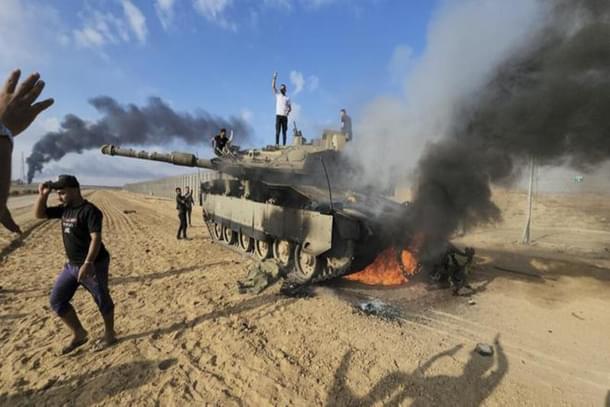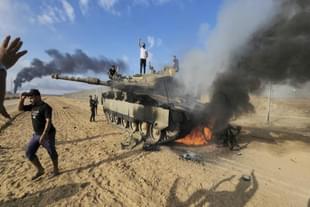World
What India Can Learn From The Israel-Hamas Crisis
Ujjwal Shrotryia
Oct 16, 2023, 06:04 PM | Updated 08:40 PM IST
Save & read from anywhere!
Bookmark stories for easy access on any device or the Swarajya app.


On the early morning of Saturday (7 October), Israel was shaken by the sound of thousands of rockets raining down on its territory.
Rockets reached as far as Tel Aviv and Jerusalem, resulting in dozens of casualties and hundreds of injuries.
Under the cover of the rocket barrage, Hamas militants managed to breach the heavily fortified Israel-Gaza border fence at multiple points, gaining access to parts of southern Israel.
What followed was a horrifying display of brutal violence reminiscent of medieval times, Islamic State (IS) style, with Hamas terrorists going from house to house, mercilessly killing any Israeli's they encountered.
Israeli woman soldiers fell victim to these atrocities, and there were reports of Hamas militants parading the naked bodies of female tourists in Gaza. Additionally, they took hundreds of hostages, including men, women, children, and the elderly.
In response to these shocking attacks, Israel declared a state of 'war' and initiated an operation codenamed 'Swords of Iron' with the objective of avenging these assaults and eradicating Hamas.
Similar to Israel, India faces an adversary on its western frontier that employs tactics reminiscent of those used by Hamas.
The tactics employed by Palestinian soldiers against Israel often find their way to Jammu and Kashmir (J&K), where Pakistan-backed Kashmiri terrorists draw inspiration from Palestinian terrorists.
In this report, we delve into the key strategic lessons that India should learn from the Israel-Hamas crisis.
Before delving deeper, it is important to provide a brief description of the highly advanced Israel-Gaza border fence.
Israel-Gaza Border Fence
The Israel-Gaza border fence spans 40 kilometres and is equipped with state-of-the-art technology, including motion sensors, thermal imagers, CCTV cameras, remotely operated gun systems, and watch towers placed every two kilometers.
Furthermore, Israeli authorities have constructed an underground anti-tunnel barrier, several metres deep, along the entire length of the fence to prevent Hamas from digging tunnels beneath it.
These anti-tunnel barriers are equipped with sensors capable of detecting underground movements and tunnel construction.
Remarkably, this formidable border fence worth over $1 billion was breached at multiple points without detection by Israeli border security.
Thousands of Hamas terrorists poured through these breaches, launching attacks on residential areas in multiple cities along the entire 40-km border.
With the context of the technologically-advanced nature of the Israel-Gaza border fence now established, let's explore some key takeaways from this conflict.
(1) Technical Intelligence (TECHINT) Cannot Replace Boots On The Ground
Despite Israel's renowned technical intelligence capabilities and a proactive intelligence network in Gaza and the West Bank, they failed to anticipate the scale and precision of Hamas's attack.
Military experts say that Israel's technical intelligence capabilities are so advanced that any electronic communications among Palestinians are intercepted by the Israelis.
So, how did the Israeli intelligence agencies not get a whiff of the impending attack?
This underscores the inherent limitation of relying solely on technical intelligence (TECHINT). It can only provide indication that something is happening. The enemy can also fool the defender by feeding misleading information, diverting focus of the defender on another front.
Imagine a scenario where a "mole" (Israeli intelligence operative) within Hamas ranks could have alerted Israeli forces about the smokescreen created by Hamas. Therefore, human intelligence (HUMINT) is equally crucial, if not more so, in detecting and understanding complex threats.
In situations like these, where adversaries adapt rapidly and employ unconventional tactics, boots on the ground and human sources can provide critical insights that technology may miss.
(2) Rationalisation Of Forces
Israel's current predicament, with active fronts in Gaza and potential threats from Hezbollah in the north, highlights the challenges of force rationalisation.
Even though the West Bank remains quiet for now, its involvement could strain Israel's resources further.
India faces the same dilemma. With both the northern and north-western borders characterised by rugged, mountainous terrain, the efficacy of force rationalisation — reducing troop numbers in favour of technology — is questionable.
These regions demand a substantial ground presence for effective operations.
Reducing manpower in frontline or reserve formations, as has been proposed, may compromise India's ability to respond effectively to multifront threats.
Boots on the ground is essential, especially considering the ongoing border tensions and the potential of a two-front scenario from China and Pakistan.
(3) Need Of Counter Drone Solutions
Despite Israel being a pioneer in unmanned military operations, their border detection system struggled to cope with the multifaceted and coordinated drone attacks by Hamas.
Videos show Hamas terrorists dropping grenades on an Israeli Merkava tank using drones, reminiscent of the Russia-Ukraine conflict.
A video released by Hamas reportedly shows a drone dropping a grenade on an Israeli remotely-operated weapon station mounted atop one of their guard towers.
These small drones are inexpensive and have a very low radar cross-section (RCS), making them extremely challenging to detect with radar.
India needs to develop and install these counter-drone systems in tactical and strategic areas, providing forces with ample reaction time to shoot down these drones.
This is especially crucial since China, the world's largest drone manufacturer, is one of India's adversaries, with over 68,000 troops engaged in an ongoing standoff along the Line of Actual Control (LAC).
Additionally, Pakistan has been employing drones to supply weapons, drugs, and counterfeit Indian currency to terrorists in Kashmir.
In June 2021, Pakistan used drones to drop two bombs near a helicopter hangar at an Indian Air Force (IAF) base in Jammu.
Moreover, in the event of war, the use of drones to drop weapons can further complicate the situation, potentially leading to a section of the local population in Kashmir turning hostile towards India.
The Defence Research and Development Organisation (DRDO) and various private companies have developed multiple such systems. The focus of the Indian armed forces should now shift toward operationalising these counter drone systems in critical areas.
(4) Mometum In Atmanirbharta Needs To Be Continued
In Israel's case, the United States and the wider West are rushing in supplies as the Jewish state begins to mobilise forces to respond to Hamas's attack.
The response from the West has been swift and resolute. This is the case despite Israel having one of the most developed military-industrial complexes in the world.
However, in India's case, this may not necessarily unfold like in Israel's case.
The supplies may come, but may not come in time or could be offered with certain conditions, like limiting India's options or what it could do to respond to the situation.
Therefore, it is necessary that India ensure its nascent drive towards Atmanirbharta in defence becomes a success.
(5) National Interest Must Trump Politics
When hostile forces breach your front door, they don't consider your political beliefs before acting.
When the nation is under attack, political parties must prioritise the well-being of the nation and society above all. While healthy debate is vital in a vibrant democracy, it should yield to national interest when needed.
Observing the actions of Benny Gantz, Naftali Bennett, and Yair Lapid, who have had their differences with Benjamin Netanyahu's government, could provide valuable insights for Indian politicians to learn from.
During any national security crisis, Indian political parties should unite in support of the Government of India (GOI) instead of pointing fingers.
This unity was demonstrated when all political parties supported the GOI just two weeks ago, following unprecedented accusations by Canadian Prime Minister Justin Trudeau regarding the murder of Khalistani terrorist Hardeep Singh Nijjar.
However, in this case, Indian political parties again presented a disjointed front. Congress, in contrast to the government's policy of condemning Hamas while also maintaining a two-state solution, stated their support for the Palestinian cause but failed to condemn Hamas's brutal attack.
This has been a challenge in India's politics. During military operations against Pakistan in Uri (2016), Balakot (2019), as well as against China in Galwan and during Operation Snow Leopard (2020), political parties failed to present a united front, often blaming the GOI.
The central government should also make efforts to foster a dialogue among all parties, keeping all parties in the loop.
In none of the above operations, the Union government made any efforts to bring all the parties on the same page.
Staff Writer at Swarajya. Writes on Indian Military and Defence.





